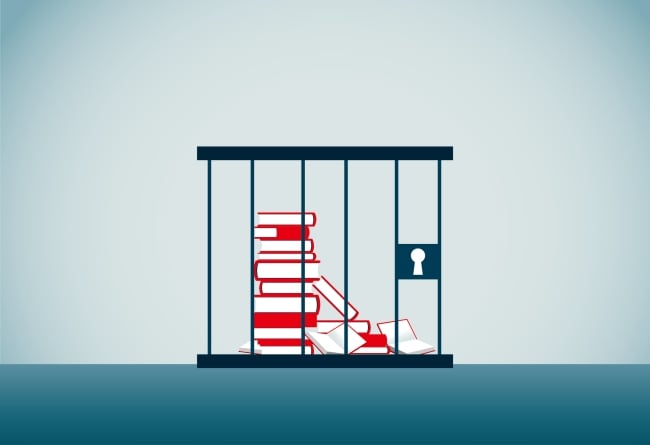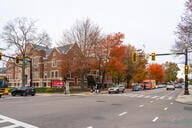You have /5 articles left.
Sign up for a free account or log in.

Incarcerated students now have expanded access to academic reading materials.
erhui1979/DigitalVision Vectors/Getty Images
Stacy Burnett has been incarcerated three times. The third time, she was sent to a New York state prison that offered higher education opportunities—and access to JSTOR, an expansive digital library of academic articles and books frequently used by students and scholars.
Burnett was taking courses through the Bard Prison Initiative, academic programs for incarcerated students offered by Bard College, and she said access to the vast trove of academic papers available through JSTOR set her on a path that ultimately changed the course of her life. Although her coursework was focused on public health, she developed a “fascination” with Oscar Wilde and spent hours reading academic materials on the author.
“I lost myself in those archives,” Burnett said. “I didn’t feel like I was in prison when I had JSTOR available to me.”
JSTOR is now accessible in 1,054 prisons, all but 17 of them in the U.S. That milestone, announced this month, was reached with the help of Burnett, who now leads the JSTOR Access in Prison Initiative as a senior project manager at ITHAKA, the parent organization of JSTOR and the higher ed consulting group Ithaka S+R.
The initiative began in 2007 and accelerated in 2021 when the Andrew W. Mellon Foundation gave ITHAKA $1.5 million to further its work on behalf of incarcerated students. The service is currently free for prisons because of subsidies from ITHAKA, Mellon and Ascendium Education Group, a philanthropic organization focused on postsecondary education.
JSTOR’s expanded reach means its digital library of millions of academic articles and tens of thousands of books is now available to at least 550,000 incarcerated people, a population that often lacks easy access to technology and library resources.
Burnett, who earned a master’s in business administration from Bard’s Graduate Programs in Sustainability after her release in 2019, said she couldn’t have dreamed of the initiative reaching so many incarcerated people a couple of years ago. She hopes it gives them the same opportunities she had.
“The idea that now there are a half a million people in that environment, who have the same capacity to discover something exciting about themselves, about the world, about anything that stimulates their curiosity, that’s really personally motivating for me,” she said. “That’s really like half a million worlds opening up.”
JSTOR is a “total game changer” for incarcerated students, said Ruth Delaney, initiative director for the Unlocking Potential initiative at the Vera Institute of Justice, a research and policy organization focused on criminal justice issues. She noted that U.S. prisons are required to have law libraries but otherwise tend to have book collections that are too limited for students to learn to parse academic resources and do research.
JSTOR access “really brings the student experience in prison in line with what a student would be learning on campus,” Delaney said.
Overcoming Barriers
Amy Jamgochian, chief academic officer at Mount Tamalpais College, which is based at San Quentin State Prison in California, finds that incarcerated students face all kinds of obstacles to accessing research materials.
Prisons often have restrictions on the kinds of books and articles students can access, including content related to “sex, violence, gang activity, illegal activity of any kind, political content that is seen as subversive or unpatriotic, and anything that is perceived as useful for criminal activity or is a perceived security threat,” she said in an email. Academic programs in prisons also tend to experience tech challenges that prevent incarcerated students from accessing research materials, including a lack of IT support and infrastructure.
Burnett said the technology available to incarcerated students for their coursework also “varies widely” across U.S. prisons, from tablets and desktop computers to decade-old Chromebooks and typewriters. Some incarcerated students have internet access, but many don’t, “so we’ve made solutions that can work in any of those environments.”
College-in-prison programs currently have three options to offer JSTOR to their students. The first is an off-line version, an index of most-cited JSTOR articles across disciplines that students can browse and request to read, and which is designed for students in “minimal tech environments,” Burnett said. She added that the off-line version is offered in at least one prison in every state.
The prison programs can also give students full online access to JSTOR content, but with any hyperlinks to social media and its customer support chat function disabled. There’s also a “mediated” online JSTOR option that allows corrections officials to review and potentially remove reading materials. However, of the prisons that adopted the mediated version, half allow students to access all JSTOR content but retain the right to evaluate materials in the future, Burnett said.
Students are taking advantage of these expanding resources. A February news release from JSTOR noted that students in Ohio prisons have accessed almost 30,000 academic articles in the past year. Students involved with the Tennessee Higher Education Initiative, a support and advocacy organization for incarcerated learners in the state, access about 2,400 articles per month, according to the release.
Dyjuan Tatro, who was incarcerated for 12 years in seven different New York state prisons, said he knows firsthand how impactful JSTOR can be—he used it when he was earning his associate and bachelor’s degrees through the Bard Prison Initiative, where he now works as its senior government affairs officer. (The initiative spurred JSTOR’s first forays into expanding access to incarcerated students in 2007, when the college’s head librarian at the time requested an off-line JSTOR index, according to a blog post from the Bard Prison Initiative.)
Tatro said he devoured a variety of reading materials through JSTOR, from mathematical papers on differential equations to The Iliad.
“When you have a population of students who are being engaged academically at the highest levels, who don’t have these very rigorous educational backgrounds, they are curious, they are intellectually hungry,” he said.
He added that expanding access to JSTOR benefits not just students but prison populations over all, because students regularly lend reading materials to others.
However, Tatro noted roadblocks that may impede JSTOR access in some prisons, including those that have no computers available to students and those that have fire hazard restrictions that limit how many books or paper materials can be in a cell at a given time. Theoretically, a student requesting too many books or printouts of JSTOR articles could lead to punitive measures.
“I think it’s great,” he said of the JSTOR expansion. “But we should always be really, really sober about what the prison is and how it operates, because it will take every opportunity to discipline individuals.”
Burnett hopes JSTOR access can also help formerly incarcerated students who continue pursuing a college education after release.
When students leave prison, “the world has changed drastically since they were incarcerated,” she said. But she believes having experience using JSTOR helps them feel more prepared to venture onto a college campus.
Delaney, of the Vera Institute, noted that JSTOR’s milestone comes at a time when college-in-prison programs are expected to proliferate and expand after Congress restored Pell Grants for incarcerated students in 2021, a change that went into effect last July. The demand for these academic tools in prisons, and the need for correctional officials to be familiar with and comfortable providing them, is bound to grow as a result.
The increase of higher ed options and access to JSTOR in prisons “work together really well to give incarcerated students a really high-quality education,” she said.





